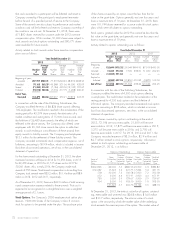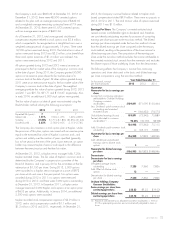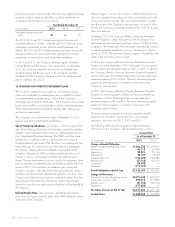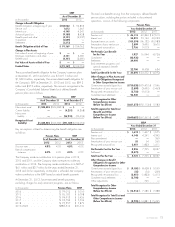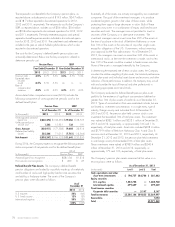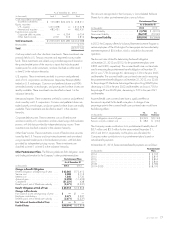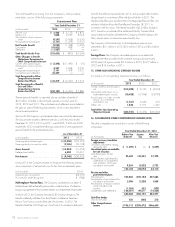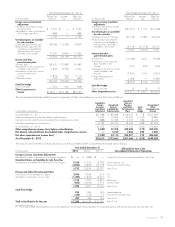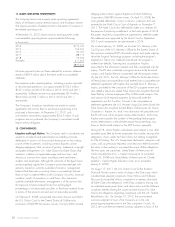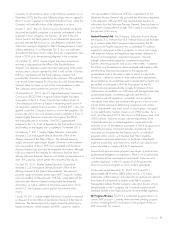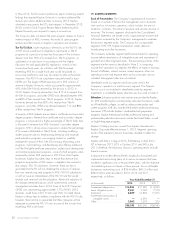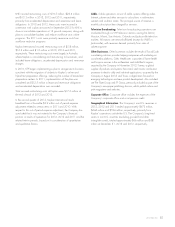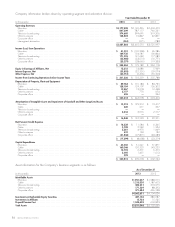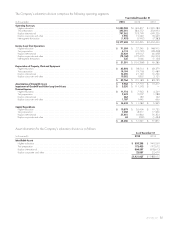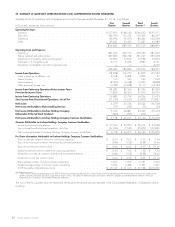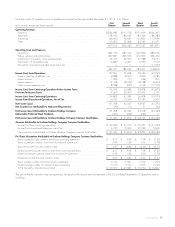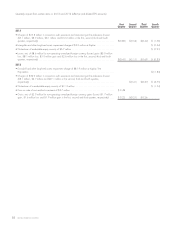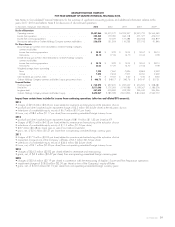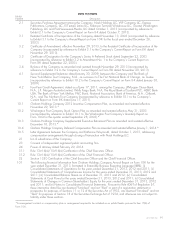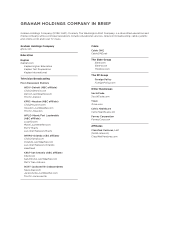Washington Post 2013 Annual Report Download - page 100
Download and view the complete annual report
Please find page 100 of the 2013 Washington Post annual report below. You can navigate through the pages in the report by either clicking on the pages listed below, or by using the keyword search tool below to find specific information within the annual report.
In May 2012, the ED issued a preliminary report containing several
findings that required Kaplan University to conduct additional file
reviews and submit additional data. In January 2013, Kaplan
submitted a response to the ED’s data request. In December 2013,
the ED issued its Final Program Review Report determining that
Kaplan University was required to repay a nominal sum.
The Company does not expect the open program reviews to have a
material impact on KHE; however, the results of open program
reviews and their impact on Kaplan’s operations are uncertain.
The 90/10 Rule. Under regulations referred to as the 90/10 rule,
a KHE school would lose its eligibility to participate in Title IV
programs for a period of at least two fiscal years if the institution
derives more than 90% of its receipts from Title IV programs, as
calculated on a cash basis in accordance with the Higher
Education Act and applicable ED regulations, in each of two
consecutive fiscal years. An institution with Title IV receipts
exceeding 90% for a single fiscal year would be placed on
provisional certification and may be subject to other enforcement
measures. The 90/10 rule calculations are performed for each
OPEID unit. The largest OPEID reporting unit in KHE in terms of
revenue is Kaplan University, which accounted for approximately
69% of the Title IV funds received by the division in 2013. In
2013, Kaplan University derived less than 81% of its receipts from
the Title IV programs, and other OPEID units derived between 69%
and 89% of their receipts from Title IV programs. In 2012, Kaplan
University derived less than 80% of its receipts from Title IV
programs, and other OPEID units derived between 71% and 88%
of their receipts from Title IV programs.
A majority of KHE students are enrolled in certificate and associate’s
degree programs. Revenue from certificate and associate’s degree
programs is composed of a higher percentage of Title IV funds than
is the case for revenue from KHE’s bachelor’s and other degree
programs. KHE is taking various measures to reduce the percentage
of its receipts attributable to Title IV funds, including modifying
student payment options; emphasizing direct-pay and employer-
paid education programs; encouraging students to carefully
evaluate the amount of their Title IV borrowing; eliminating some
programs; cash-matching; and developing and offering additional
non-Title IV-eligible certificate preparation, professional development
and continuing education programs, some of which programs were
acquired by certain KHE campuses in 2013 from other Kaplan
businesses. Kaplan has taken steps to ensure that revenue from
programs acquired by a KHE campus is eligible to be counted in
that campus’ 90/10 calculation. However, there can be no
guarantee that the ED will not challenge the inclusion of revenue
from any recently acquired program in KHE’s 90/10 calculations
or will not issue an interpretation of the 90/10 rule that would
exclude such revenue from the calculation. Absent the adoption of
the changes mentioned above, and if current trends continue,
management estimates that in 2014, three of the KHE Campuses’
OPEID units, representing approximately 1.7% of KHE’s 2013
revenues, could have a 90/10 ratio over 90%. As noted above,
Kaplan is taking steps to address compliance with the 90/10 rule;
however, there can be no guarantee that these measures will be
adequate to prevent the 90/10 ratio at some of the schools from
exceeding 90% in the future.
19. BUSINESS SEGMENTS
Basis of Presentation. The Company’s organizational structure is
based on a number of factors that management uses to evaluate,
view and run its business operations, which include, but are not
limited to, customers, the nature of products and services and use of
resources. The business segments disclosed in the Consolidated
Financial Statements are based on this organizational structure and
information reviewed by the Company’s management to evaluate
the business segment results. The Company has six reportable
segments: KHE, KTP, Kaplan International, cable, television
broadcasting and other businesses.
The Company evaluates segment performance based on operating
income before amortization of intangible assets and impairment of
goodwill and other long-lived assets. The accounting policies at the
segments are the same as described in Note 2. In computing
income from operations by segment, the effects of equity in earnings
(losses) of affiliates, interest income, interest expense, other non-
operating income and expense items and income taxes are not
included. Intersegment sales are not material.
Identifiable assets by segment are those assets used in the
Company’s operations in each business segment. The Prepaid
Pension cost is not included in identifiable assets by segment.
Investments in marketable equity securities are discussed in Note 4.
Education. Education products and services are provided by Kaplan,
Inc. KHE includes Kaplan’s postsecondary education businesses, made
up of fixed-facility colleges, as well as online postsecondary and
career programs. KHE also includes the domestic professional training
businesses. KTP includes Kaplan’s standardized test preparation
programs. Kaplan International includes professional training and
postsecondary education businesses outside the United States, as well
as English-language programs.
Kaplan’s Colloquy business moved from Kaplan International to
Kaplan Corporate effective January 1, 2013. Segment operating
results of the education division have been restated to reflect this
change.
Kaplan sold Kidum in August 2012, EduNeering in April 2012,
KLT in February 2012, KCS in October 2011 and KVE in July
2011; therefore, the education division’s operating results exclude
these businesses.
In response to student demand levels, Kaplan has formulated and
implemented restructuring plans at its various businesses that have
resulted in significant costs in the past three years, with the objective
of establishing lower cost levels in future periods. Across all Kaplan
businesses, restructuring costs of $36.4 million, $45.2 million and
$28.9 million were recorded in 2013, 2012 and 2011,
respectively, as follows:
Year Ended December 31
(in thousands) 2013 2012 2011
Accelerated depreciation ..... $16,856 $17,230 $ 3,965
Lease obligation losses ....... 9,351 9,794 7,570
Severance ................ 6,289 14,349 17,205
Accelerated amortization of
intangible assets .......... —2,595 —
Other ................... 3,862 1,274 205
$36,358 $45,242 $28,945
82 GRAHAM HOLDINGS COMPANY


